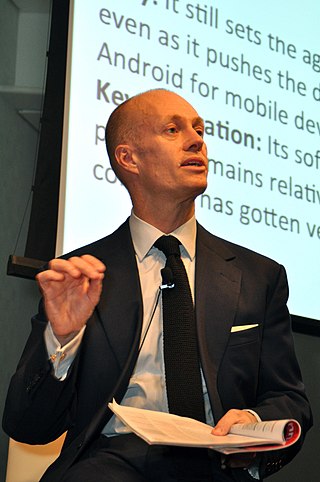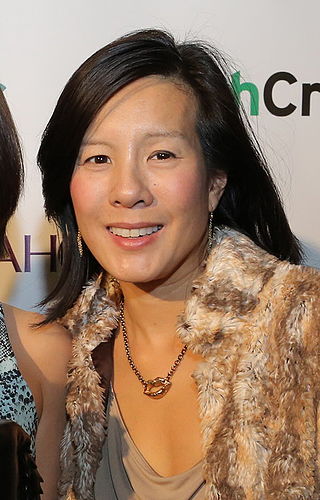Upside was a San Francisco-based business and technology magazine for venture capitalists. It was published from 1989 to 2002. It had a circulation above 300,000.

Vinod Khosla is an Indian-American billionaire businessman and venture capitalist. He is a co-founder of Sun Microsystems and the founder of Khosla Ventures. Khosla made his wealth from early venture capital investments in areas such as networking, software, and alternative energy technologies. He is considered one of the most successful and influential venture capitalists.
Alex Serge Vieux is the chairman and publisher of Red Herring and CEO of Herring International. Through Red Herring Top 100 and other events, Vieux analyzes the potential of approximately 2,000 startups each year. His contributions to the IT industry span more than 20 years and include co-founding of DASAR, a European incubator and conference company. Currently, Vieux serves on the boards of several international public and private companies, including BVRP, CommerceOne, CheckPoint Software, Daum Communications and Kyriba.

Silicon Alley is an area of high tech companies centered around southern Manhattan's Flatiron district in New York City. The term was coined in the 1990s during the dot-com boom, alluding to California's Silicon Valley tech center. The term has grown somewhat obsolete since 2003 as New York tech companies spread outside of Manhattan, and New York as a whole is now a top-tier global high technology hub. Silicon Alley, once a metonym for the sphere encompassing the metropolitan region's high technology industries, is no longer a relevant moniker as the city's tech environment has expanded dramatically both in location and in its scope. New York City's current tech sphere encompasses a universal array of applications involving artificial intelligence, the internet, new media, financial technology (fintech) and cryptocurrency, biotechnology, game design, and other fields within information technology that are supported by its entrepreneurship ecosystem and venture capital investments.

Fast Company is a monthly American business magazine published in print and online that focuses on technology, business, and design. It publishes six print issues per year.

Jason Matthew Daniel Pontin is a British-born venture capitalist and journalist. He is a General Partner at the venture capital firm of DCVC in Palo Alto, and is a board member and seed investor in a number of life sciences companies. He is the former editor in chief and publisher of MIT Technology Review.

Jason McCabe Calacanis is an American Internet entrepreneur, angel investor, author and podcaster.

Domino is an American home magazine which was in circulation between April 2005 and March 2009, and then relaunched as a print and digital magazine and ecommerce platform in October 2013.
The Industry Standard is a U.S. news web site dedicated to technology business news, part of InfoWorld, a news website covering technology in general. It is a revival of a weekly print magazine based in San Francisco which was published between 1998 and 2001.

Vishal Gondal is an Indian entrepreneur and angel investor. He is the founder and CEO of GOQii.

Jerry Colonna is an American venture capitalist and professional coach who played a prominent part in the early development of Silicon Valley. Colonna has been named to Upside magazine's list of the 100 Most Influential People of the New Economy, Forbes ASAP's list of the best VCs in the country, and Worth's list of the 25 most generous young Americans. He is a co-founder and CEO of the executive coaching and leadership development company, Reboot. He is the host of the Reboot Podcast. He also serves as chairman on the Board of Trustees at Naropa University.

Lucidworks is a San Francisco, California-based software company that specializes in commerce, customer service, and workplace applications.

David Semel Rose is an American serial entrepreneur and angel investor. He is an investor in startup technology companies and founder of New York Angels, an early-stage technology investment group. He is Managing Partner of Rose Tech Ventures, a venture fund focused on Internet-based business, and CEO of Gust, which operates a collaboration platform for early stage angel investing.
Panaya is a global technology company based in Hod Hasharon, Israel. The company is a subsidiary of Infosys, and has offices in North America, Europe and Japan. It is a SaaS based company certified by SAP, Oracle and Salesforce.com, offering an all-in-one platform for Smart Testing solutions and Change Intelligence, tailored for Enterprise Resource Planning (ERP), Customer Relationship Management (CRM) and cloud-business applications.

Aileen Lee is a U.S. venture capital angel investor and co-founder of Cowboy Ventures.
Kenandy is a Rootstock Software company, is an American business-to-business software provider founded by tech entrepreneur Sandra Kurtzig. Kenandy is a vendor to combine quote to cash and enterprise resource planning in a single cloud computing solution. Kenandy is also a full-function enterprise resource planning vendor that runs native on the Salesforce.com App Cloud.
CloudHealth Technologies, now CloudHealth by VMware, is a privately held software company based in Boston, Massachusetts. The company provides cloud computing services related to cost management, governance, automation, security, and performance.

Scripbox is a Bengaluru-based digital wealth management service founded in 2012.
Livspace, is a home interior and renovation company headquartered in Singapore. It provides interior design and renovation services in Singapore and India. The company was founded in 2014 by Anuj Srivastava and Ramakant Sharma and has raised funding of $450 million.
Servify is a device management platform, founded in 2015. It is headquartered in Mumbai, India and operates in North America, Europe, Middle East, China and Turkey. It provides services such as product diagnosis, queue management, warranty and protection plans to its clients. In 2019, Servify was featured in Red Herring Asia Top 100 Technology company list.












